
Latrodectus mactans, known as southern black widow or simply black widow, and the shoe-button spider, is a venomous species of spider in the genus Latrodectus. The females are well known for their distinctive black and red coloring and for the fact that they will occasionally eat their mates after reproduction. The species is native to North America. The venom can cause pain and other symptoms, but is rarely fatal to healthy humans.

Wolf spiders are members of the family Lycosidae, so named for their robust and agile hunting skills and excellent eyesight. They live mostly in solitude, hunt alone, and usually do not spin webs. Some are opportunistic hunters, pouncing upon prey as they find it or chasing it over short distances; others wait for passing prey in or near the mouth of a burrow.

Latrodectus is a broadly distributed genus of spiders with several species that are commonly known as the true widows. This group is composed of those often loosely called black widow spiders, brown widow spiders, and similar spiders. However, the diversity of species is much greater. A member of the family Theridiidae, this genus contains 34 species, which include several North American "black widows". Besides these, North America also has the red widow Latrodectus bishopi and the brown widow Latrodectus geometricus, which, in addition to North America, has a much wider geographic distribution. Elsewhere, others include the European black widow, the Australian redback spider and the closely related New Zealand katipō, several different species in Southern Africa that can be called button spiders, and the South American black-widow spiders. Species vary widely in size. In most cases, the females are dark-coloured and can be readily identified by reddish markings on the central underside (ventral) abdomen, which are often hourglass-shaped.
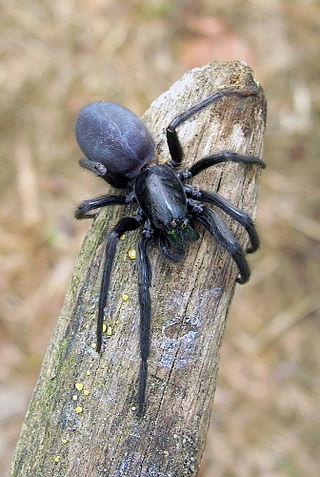
Tube-dwelling spiders (Segestriidae) are a family of araneomorph spiders first described by Eugène Simon in 1893. It consists of five genera, two large and widespread, Segestria and Ariadna, and three smaller genera, Citharoceps, Gippsicola and Indoseges. They are haplogyne spiders, related to the Dysderidae and placed in clade or superfamily Dysderoidea.

Velvet spiders are a small group of spiders almost entirely limited to the Old World, with the exception of one species known from Brazil. In Europe, some are commonly called the ladybird spiders.

The woodlouse spider is a species of spider that preys primarily upon woodlice. Other common names refer to variations on the common name of its prey, including woodlouse hunter, sowbug hunter, sowbug killer, pillbug hunter and slater spider.

Steatoda grossa, commonly known as the cupboard spider, the dark comb-footed spider, the brown house spider, or the false widow or false black widow, is a common species of spider in the genus Steatoda.
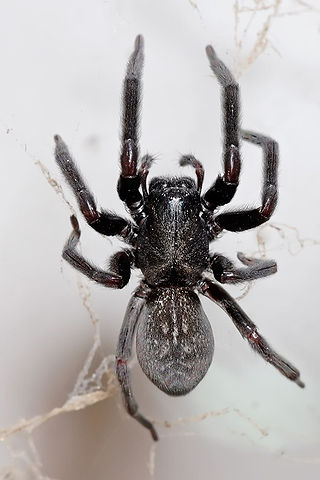
The black house spider or common black spider is a common species of cribellate Australian spider, introduced to New Zealand and Japan. A closely related species, Badumna longinqua, the grey house spider, has a similar distribution, but has also been introduced to the Americas.
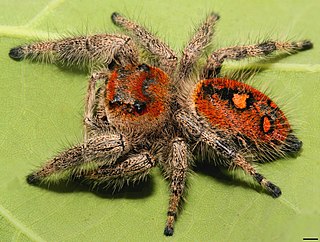
Phidippus regius, commonly known as the regal jumper, is a species of jumping spider found in parts of the United States and the Caribbean. It is the largest species of jumping spider in eastern North America.

Ballus chalybeius is a jumping spider. It is the type species of the genus Ballus.

Scytodes thoracica is a spitting spider, so called because it spits a venomous sticky silken substance over its prey. Its size ranges between 3–6 mm (0.12–0.24 in). The carapace is unusual in sloping upwards towards its rear end, whereas the abdomen slopes downwards.

Larinioides cornutus, the furrow spider, furrow orb spider, or foliate spider is an orb-weaver spider with Holarctic distribution. Orb weaver bites are not especially dangerous for humans, though symptoms include mild pain, numbness, and swelling. Rarely, nausea and dizziness may occur.
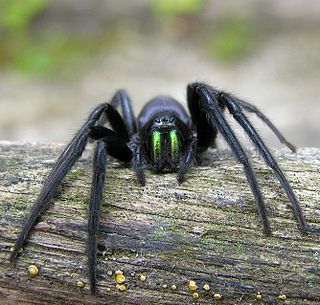
Segestria florentina is the biggest European segestriid spider. Some vernacular names are green-fanged tube web spider and cellar spider, although the latter is not exclusive to this species.
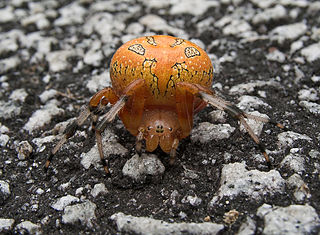
Araneus marmoreus, commonly called the marbled orbweaver, is a species of spider belonging to the family Araneidae. It is sometimes also called the pumpkin spider from the resemblance of the female's inflated abdomen to an orange pumpkin. It has a Holarctic distribution.

Tarantulas comprise a group of large and often hairy spiders of the family Theraphosidae. As of December 2023, 1,100 species have been identified, with 166 genera. The term "tarantula" is usually used to describe members of the family Theraphosidae, although many other members of the same infraorder (Mygalomorphae) are commonly referred to as "tarantulas" or "false tarantulas". Some of the more common species have become popular in the exotic pet trade. Many New World species kept as pets have setae known as urticating hairs that can cause irritation to the skin, and in extreme cases, cause damage to the eyes.

Metepeira labyrinthea, the labyrinth orbweaver, is a spider, with thin legs and a round, bulbous abdomen It is a member of the genus Metepeira in the family Araneidae. The female’s length is 5.3 mm, its carapace 2.3 mm, abdomen 3.3 mm, and extended legs 18.4 mm. The carapace is brown or gray, and the abdomen is dark with a white pattern. The legs alternate pale brown and dark brown, and the sternum is dark brown with a longitudinal yellow mark. The male spider is three-quarters of the female’s length, or slightly larger, with a darker carapace and with greater contrast between dark and light areas of the legs. Metepeira are easily distinguished from other Araneidae by their light eye region, white median line on the sternum, relative length of the leg segments, small male palpus, weakly sclerotized epigyne and the special composite web.

Psalmopoeus cambridgei, the Trinidad chevron tarantula, is a species of spider in the family Theraphosidae, endemic to Trinidad. Its venom is the source of psalmotoxin and vanillotoxin which are classified as inhibitor cystine knot proteins. Psalmotoxin may be of therapeutic use in patients with a stroke.

The Cave of the Silken Web a.k.a. Journey to the West - the Spiders Cave a.k.a. Spiders is a 1927 Chinese film directed by Dan Duyu and starring Yin Mingzhu as the first spider spirit. It is based on an episode of the shenmo fantasy novel Journey to the West, a Chinese literary classic written in the Ming Dynasty.

Aphonopelma marxi is a species of spider in the family Theraphosidae (tarantulas), found in United States. Aphonopelma behlei and A. vogelae, at one time considered separate species, are now considered to be synonyms.

Heliophanus cupreus, the copper sun jumper, is a species of jumping spider belonging to the family Salticidae.




















